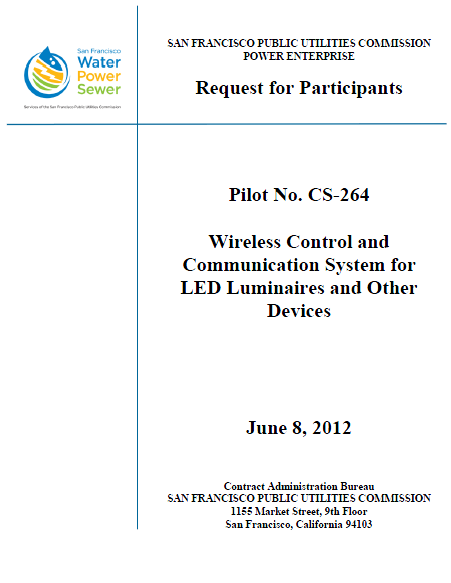The following request for participants (RFP) was issued by the San Francisco Public Utilities Commission on June 8, 2012. The RFP concerns the construction of a wireless control and communications system for managing the city’s future network of dimmable LED streetlights. The RFP states that future uses for the secure wireless network may include street surveillance, gunshot monitoring, public information broadcasts, electric meter reading and pollution monitoring. For more information on the project, see Rebecca Bowe’s recent article in the San Francisco Bay Guardian.
Pilot No. CS-264 To Pilot Wireless Control and Communications System for LED Street Lights and Other Devices
- 18 pages
- June 8, 2012
The SFPUC owns and maintains approximately 18,500 cobra-head type high pressure sodium (HPS) luminaires, located throughout the City of San Francisco’s forty-nine square miles. The SFPUC anticipates replacing the existing HPS street light luminaires with dimmable LED luminaires in the next two years. The SFPUC also plans to install an integrated wireless communication monitoring and control system (wireless system) to remotely manage the LED street lights. The SFPUC would prefer to install the wireless system as part of the SFPUC LED Streetlight Conversion Project, but will consider purchasing luminaires and installing the wireless system at a later date. Ideally, the wireless system will accommodate other wireless devices, unrelated to street lighting, in a common wireless system mesh network.
The City has multiple needs for the secure wireless transmission of data throughout its various neighborhoods and districts. Future needs for the secure wireless transmission of data throughout the City may include:
• Electric vehicle charging stations data transmission
• Electric meter reading
• Gunshot monitoring
• Street surveillance
• Public information broadcasts
• Street parking monitoring devices
• Traffic monitoring
• Traffic signal control
• Pollution monitoring
• Others…
A. General
The purpose of the RFP and subsequent Pilot Project is to identify innovative possibilities unknown to the SFPUC that may be relevant to City agencies in the future. Respondents are invited to define the characteristics and features of an innovative solution for LED street light control, and include this description in their submittal. The information below is provided to help Respondents identify products that meet the SFPUC’s desired performance criteria for LED street light controls, and to guide the submittal as is relates to wireless control of LED luminaires. It is not intended to limit the scope of the SFPUC’s interest in multifunctional wireless systems.
B. Desirable Wireless System Features
1. Endpoint and Gateway Features:
a. UL listing;
b. NEMA and IP rated;
c. ANSI C136.10-2006 compliance;
d. NTCIP 1213 compliance;
e. Solid state and HID lighting compatibility;
f. 120V/240V compatibility;
g. Back-up astronomical clock;
h. Antenna that is less than 4” long;
i. 0-10V dimming capability;
j. Components that can be mounted on or within the luminaire, arm or streetlight pole; and
k. Self-commissioning capability.2. Network Features:
a. Data encryption per AES 128 or 256; and
b. SFPUC hosting of wireless network and data.
3. Controls and Software Functions:
a. Web portal customization per SFPUC requirements;
b. On/off scheduling;
c. Failure detection;
d. Ability to record events and report historical data;
e. Remote, secure web-based access of monitoring and control functions;
f. Luminaire grouping;
g. Automated detection and reporting of cycling lamps, fault conditions, or malfunctioning equipment and hourly reporting of voltage, current, power factor, and energy consumption data at interval of at least 1 transmission per hour;
h. Lumen depreciation adjustment, defined here as gradually increasing LED drive current over time to compensate for light source depreciation. Adaptive lighting capability, defined here as dimming LED streetlight with wireless controls, based upon scheduled dimming events [AND/OR] pedestrian and traffic motion sensor feedback]; and
i. GPS mapping function that provides a geographical representation of streetlights’ locations and operational status.C. The following types of systems and/or solutions will not be considered:
1. Systems that do not default lighting controls to “on” in the event of a failure in controls hardware or network communication;
2. Power line carrier communication systems;
3. Systems that are not compatible with solid state lighting;
4. Systems that do not integrate pedestrian and traffic sensors; and
5. Non-dimmable LED street light control systems.

